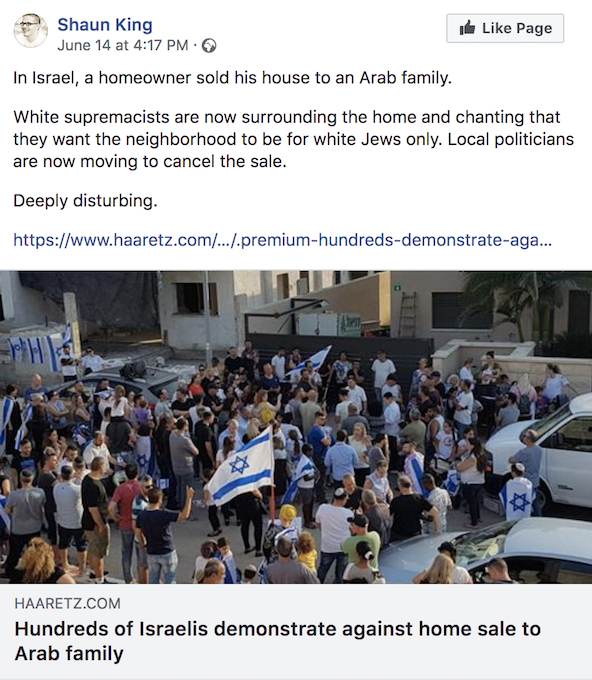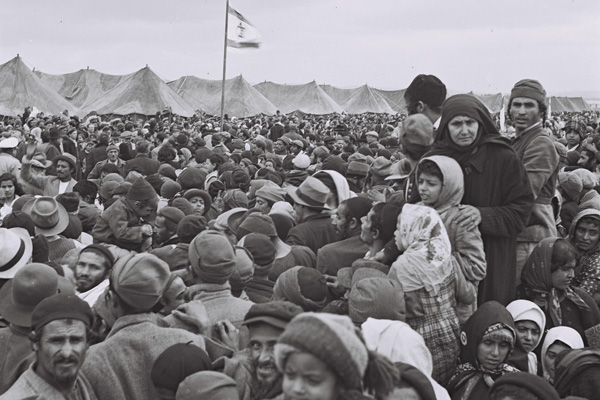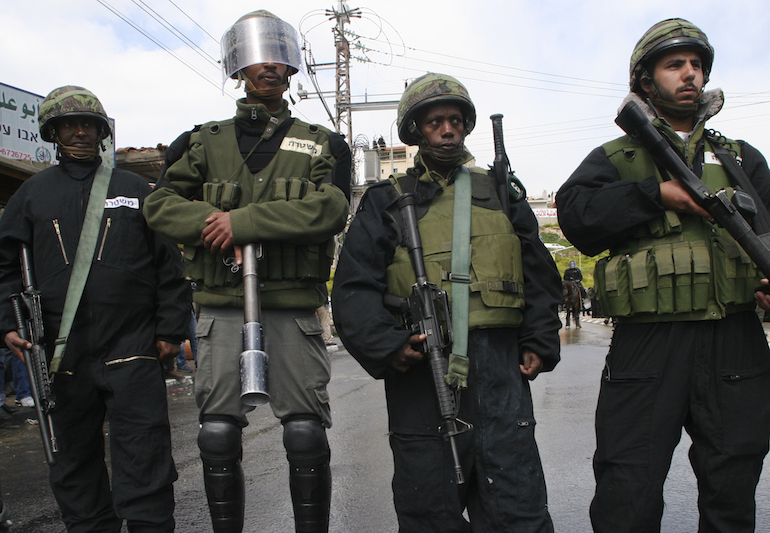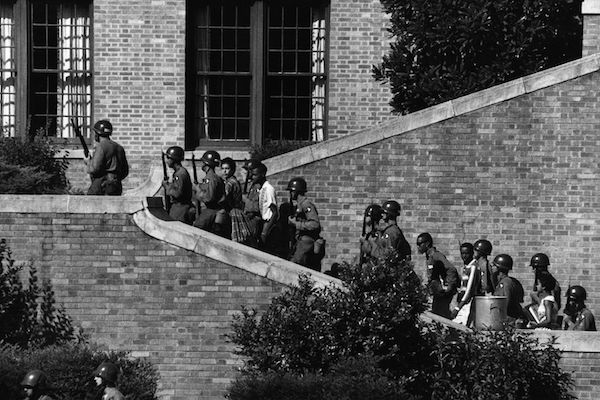Protests against an Arab family moving into an all-Jewish neighborhood in northern Israel have sparked worldwide condemnation and accusations of ‘white supremacy.’ But understanding the ways Jewish supremacy and white supremacy work in Israel is the first step toward dismantling them.
By Lihi Yona
Over the past few weeks, protests have rocked the northern Israeli city of Afula, following news that an Arab family was moving into the Yizrael Quarter neighborhood. The demonstrators, who were joined by the former mayor of Afula, say they are “not racist,” and that they believe that Jews and Arabs should live separately.
Shaun King, an American writer, civil rights activist and a brilliant commentator on race relations in the U.S, shared the story on his Facebook page, writing: “White supremacists are now surrounding the home and chanting that they want the neighborhood to be for white Jews only.”

But King, who has been instrumental in bringing light to injustices against racial minorities in the United States, simply gets the story wrong. Afula is not a city of “white Jews,” and the struggle against Arabs moving to the neighborhood does not stem from a desire to turn Afula into a city of white Jews. Afula is a middle and working class city with a clear Mizrahi (Jews from Arab and/or Muslim countries) identity, which over the last few decades has absorbed immigration waves from Ethiopia and former Soviet countries.
But, one could insist, why does this matter? Jews — Mizrahim or Ashkenazim (Jews from Eastern Europe) — are gathering by the dozens alongside the former mayor, to protest selling a home to an Arab. The unconscionable, open-faced racism perhaps brings up memories of Jim Crow in the United States, and the ideology that guides these protests is one of supremacy — just as King noted.
And yet, we must ask whether what we are seeing in Afula is a display of Jewish supremacy or white supremacy. In that regard, King’s mistake raises one of the key political dilemmas in Israeli society.
Layers of supremacy
Israel and the Zionist project were indeed formed on the basis of a Jewish supremacy. Israel was, after all, established as a Jewish and democratic state, in which the rights of Jews are anchored in a set of laws that grant them privileges, from the Law of Return, to the Absentees’ Property Law, and so on.
But, simultaneously, the Zionist project in Israel sought to promote its own brand of white supremacy. “White” Jews, — that is, Jews who came from Europe and North America — were granted a set of benefits and privileges in Israel at the expense of Jews who came from Arab and Muslims countries. Government decisions made in the early days of the state led to the creation of separate trajectories within the Jewish public in Israel — including the kidnapping of Jewish babies of mostly Mizrahi origin, the siphoning off of the best land for communities populated by Ashkenazim, and the creation of separate, unequal educational systems for non-white Jews.

Granting enormous privileges — both economic and political — to white Jews in Israel-Palestine has shaped the racial/ethnic landscape in Israel today. This is a critical point, since economic privileges enable those at the top of the ladder to take on a kind of “moral façade.” Those who live in wealthy, gated communities protected by admissions committees do not need to resort to “blatant” racism or shows of extreme nationalism in order to exclude the “other.”
From this perspective, the anti-integration protests in Afula are on the one hand in line with the discriminatory policies that characterize Israel’s regimes of supremacy: Jewish and white. However, they are also lower class, non-white in nature, as only those at the bottom of the social ladder must resort to protests for the “right” to live in an ethnically pure city — a need that wealthy Israeli Jews can simply buy.
The fuel of the occupation
Yet at this point the careful reader could insist: why, after all, should any of this matter? Why should anti-Mizrahi racism matter to a Palestinian citizen whose only desire is to move into a new house? Racism is racism.
That’s absolutely true. To that Palestinian it does not matter. The racism expressed in this protest ought to be severely and wholeheartedly condemned. However, the confusion between the regime of Jewish supremacy and the regime of white supremacy, or the misguided notion that sees all Jews as a homogenous group serves the interests of both these regimes of supremacy. In that sense, failing to acknowledge Mizrahi existence and discrimination fuels not only the supremacy of white Israelis — but also the engines of the occupation.
Housing discrimination against Mizrahim, for instance, pushed many families to the settlements, where homes were more affordable for those who did not have the economic privileges of settling in Palestinian houses inside the Green Line. Similarly, educational segregation and inequality further pushes many young Mizrahim to advance their socio-economic status through “meaningful service” in the Israeli security forces, as Tom Mehager recently wrote.

Moreover, conflating race and nationality and the ways in which both operate within Israel allows the Zionist project to present itself solely as a religious-based national project, avoiding the racial complexities and supremacist ideology at its core. This is a story Israel prefers, since it blurs the colonial dimensions that have characterized at least some strands of Zionist ideology, which sought to become “a portion of a rampart of Europe against Asia, an outpost of civilization as opposed to barbarism” in the words of Theodor Herzl.
Only a political alternative that recognizes the historical and current predicament of non-white Jews may prove to be relevant to those who remain suspicious of the Israeli left, whose political parties have been historically linked to Israel’s white supremacy. A left-wing agenda that focuses on Afula as the epitome of racism in Israel will continue to alienate Mizrahi communities — the same communities who for years have watched as the left gave its tacit support to building towns, neighborhoods, and schools where neither Mizrahim nor Palestinians were welcome. Thus, negating Mizrahi existence will leave the left small in both numbers and influence.
From Afula to Little Rock

This is not a call to understand racists, but rather to understand racism. Race, after all, is not a biological fact. As Ta-Nehisi Coates writes in Between the World and Me, “race is the child of racism, not the father.” And yet, while we often develop a critical standpoint regarding the way historically oppressed races were formed — their historical makeup, as well as their intersectional, conflicting identities — we continue to take dominant races for granted, as if they emerged directly from the alchemist’s fire: complete, whole, cohesive products.
But realizing that even hegemonic races contain inner conflicts is vital to understanding racial categories as man-made mechanisms, designed to serve the power structure that birthed them.
In addition, understanding Israeli racial dynamics could potentially provide valuable insight vis-à-vis American race relations as well: take Little Rock, Arkansas, one of the most famous sites in the battle against segregation in the U.S. Instead of attempting to desegregate so-called ‘Cadillac High,’ attended by upper-class white students, civil rights activists chose Little Rock Central High School, which served the city’s poor white population. In Little Rock, like in Afula, money bought the white elite’s moral façade — the ability to look on from afar, appalled at those demonstrating against integration.
Like most complicated things, supremacy is often messy. It is almost always easier to be disgusted by blatant displays of racism, but it is almost always more effective to come closer and recognize that race is never a natural phenomenon. Only by grappling with race as a construct can we understand how, along with religion, nationality, gender, and class, it operates to build borders, separations, and false senses of security. At first glance, acknowledging these intersections and complications might seem like a setback in the struggle to bring down these very borders, but only through that realization can we form broad coalitions, strong enough to tear down walls — from Little Rock all the way to Afula.
Lihi Yona is a JSD candidate at Columbia Law School and a young scholar at the Israel Democracy Institute, writing on legal race theory in the Israeli and American context.
